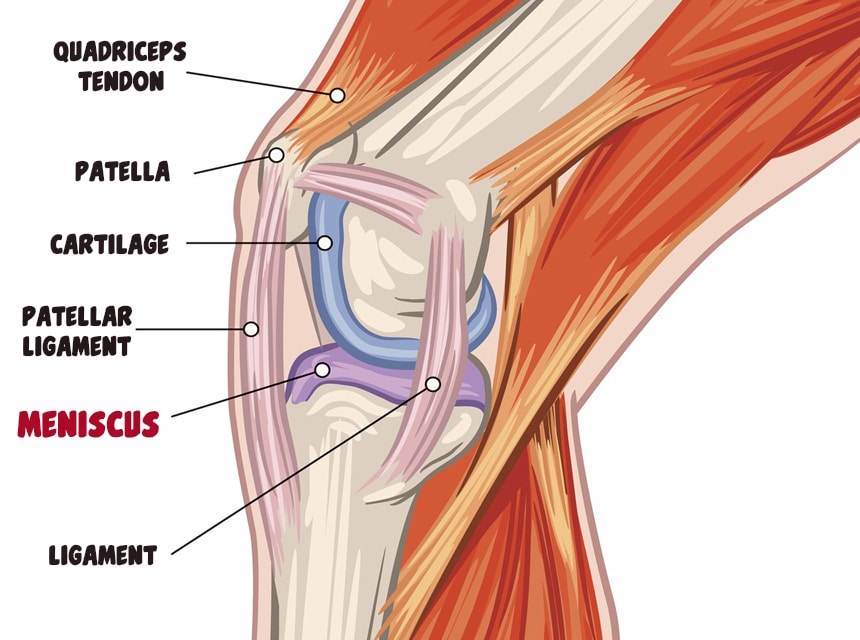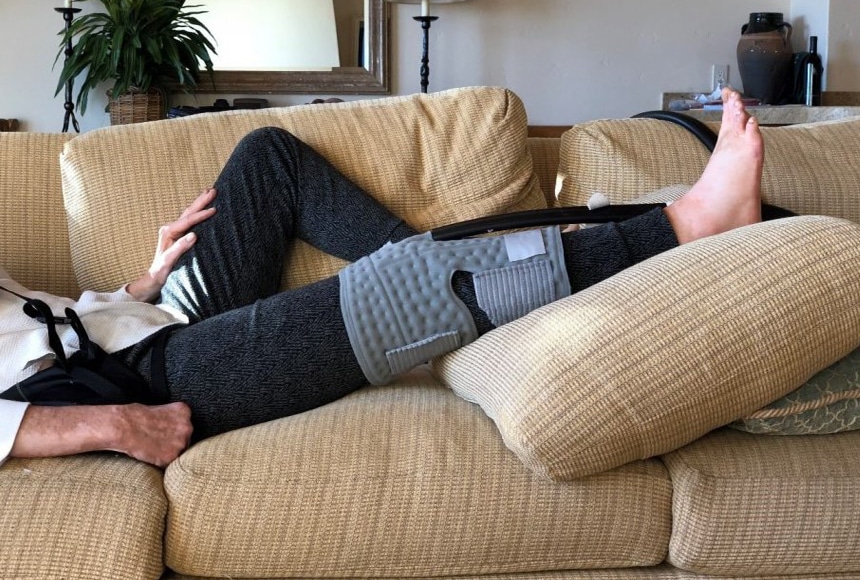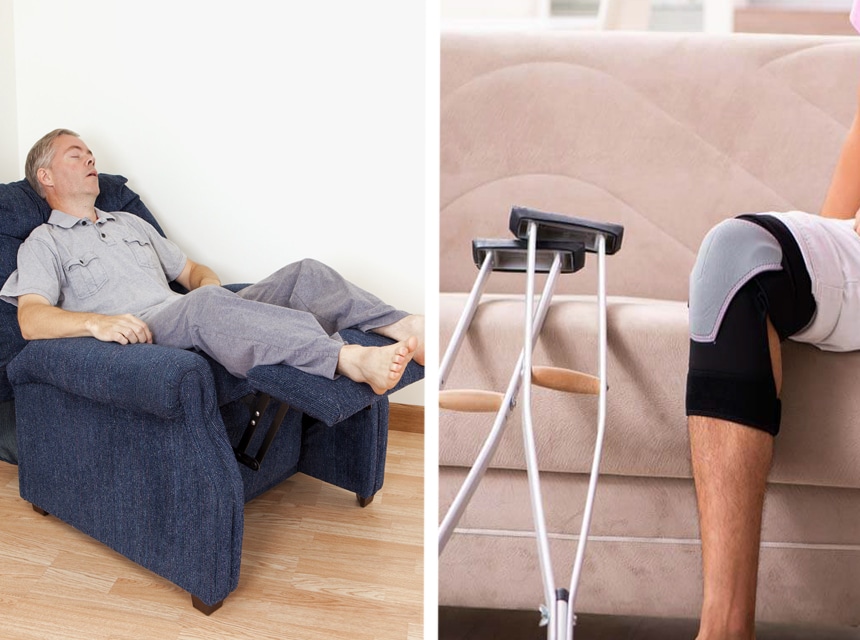

Getting a good night’s sleep can often be challenging. Trying to get a good night’s sleep with an injury or even after surgery adds to the challenge of getting restful sleep. This is especially the case when the type of surgery affects your normal sleeping position. Suddenly being forced to sleep in a different or awkward position can aggravate your injury or keep you awake. Meniscus surgery is one of the most common surgeries that require you to change your sleeping habits to aid recovery. This may leave you wondering, ‘how to sleep after meniscus surgery?
In today’s article, we’ll be highlighting a few simple, easy-to-follow tips to help you sleep after meniscus surgery. If you’ve recently suffered a knee injury or just been for this operation, we urge you to keep reading!

Ultimately, a meniscus stabilizes the knee joint and prevents bones from wear and tear. A torn meniscus is one of the more common knee injuries. Milder injuries can heal on their own, while more severe tears will require surgery and a considerable amount of recovery time.
A torn meniscus can be quite painful and produces well-localized pain in the affected knee. The pain is often worsened during twisting, moving, or squatting motions. If the torn meniscus hasn’t locked your knee, you’ll be able to stand, walk and sit without too much pain.
Some of the clear indications that your torn meniscus has locked your knee include the following:
The best treatment for a meniscal tear depends largely on the location and severity of the damage. Some tears heal by themselves in about 6 to 8 weeks. The good news is, only a fraction of meniscus injuries require surgery.
Milder meniscal tear injuries can be treated with the following non-surgical treatments:
Unfortunately, conservative treatments don’t always do the trick. A large tear will require surgery to repair the meniscus. While the surgery is a simple enough procedure, there will be some recovery time needed.
For the most part, full recovery can take as long as 6 months. It’s important to get sufficient rest and use crutches and a knee brace to aid walking. Wherever possible, stay off your sore leg and avoid any exercise.
Proper rest and adequate sleep are crucial to recovery. This might be easier said than done if your favorite sleeping position puts you right on the injured knee!
There are, however, a few things you can do to make the healing process considerably easier. We’ve listed a few simple tips to remind you of what to do to keep yourself off your leg. Our tips will also help you get a better night’s sleep as you adjust to your new sleeping positions.
To prevent infections, it’s crucial to keep dressings clean and dry Trusted Source Incision Care After Surgery | Michigan Medicine Your doctor used either stitches, staples, tissue glue, or tape strips to close the incision. And you will need to keep the area clean, change the dressing according to your doctor’s instructions, and watch for signs of infection. www.uofmhealth.org for the first 3 to 5 days after surgery at least. Depending on stitches, your doctor might recommend you clean the wound and replace bandages twice daily. Your doctor will advise you of the exact procedures to follow regarding this process.
Speak to the doctor or nurse about the use of waterproof bandages for showering. After using these types of bandages, replace them with dry ones. Alternatively, you’ll have to settle for washing yourself without getting into the bath.
Don’t scrub, scratch or pick at your wound. Keeping the wound dry is the only way it will dry and start healing. Make sure the bandages aren’t too tight, as this will cut off circulation. Go back to the doctor if the wound leaks or starts bleeding.

An innovative pillow that will help with this is the ComfiLife Orthopedic Knee Pillow. This ergonomically designed knee pillow fits comfortably between your knees and provides the comfort your knee needs after surgery.
It also keeps your hip, legs, and spine in ideal alignment. Made with premium high-density foam, this 100% premium quality pillow is often referred to as one of the best knee pillows.
It might seem obvious, but you should focus on sleeping on the “good leg.” If you’re not usually a back sleeper, it can be difficult to get used to sleeping in this position.
Sleeping on your side or stomach can also be uncomfortable because you could accidentally roll onto the sore leg. Place a pillow between your legs and try not to sleep on the sore leg!
If you find yourself rolling over onto the sore leg in your sleep, try packing pillows next to the sore leg, making it harder to roll over onto it.
One way to deal with the struggle to sleep can be to focus on relaxing. By becoming more relaxed, you’ll sleep better, which is crucial to your recovery. Practice breathing exercises if you find it difficult to unwind and drift off to sleep.
Alternatively, focus on doing something that relaxes you, such as reading or meditation. Keeping still and relaxed prevents your body from tensing up. Having a tensed-up body will only add to the pain you’re feeling.
Be sure to ask your doctor for some pain medication to help you get through the first few days of recovery. While not everyone experiences severe pain after surgery, many patients record feeling an intense, pulsing ache.
Sufficient pain medication is the first line of defense for surgeries, broken ribs, and fractured pelvis injuries. You’ll feel a little more comfortable if you aren’t in constant pain all the time!
Your pain receptors will tell you soon enough that you shouldn’t bend your knee while sleeping! Bending your knee slows down the recovery process and may cause further injury to the meniscus.
If you’re a side sleeper, it might be difficult to sleep without bending your knee. A Calming Comfort Cooling Knee Pillow not only aligns your spine but also alleviates the pressure side sleeping places on your back. It’s no wonder it’s commonly listed on the list for best pillows for side sleepers.

Ensure that your leg can be elevated with enough space for a pillow. Recliners are always a clever idea because they keep your whole body supported and allow you to move your leg into various positions. If you’re going to sit somewhere else in the house, make sure your crutches are nearby for when you need to get to the bathroom!
Getting a good night’s sleep is essential for your recovery process. Learning how to sleep after meniscus surgery isn’t as difficult as you might imagine. The right pain medication regime combined with our effortless tips will go a long way toward easing your pain and speeding up your recovery. A faster recovery rate will allow you to go back to sleeping normally in no time!





